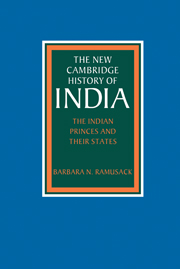Book contents
- Frontmatter
- 1 Introduction: Indian princes and British imperialism
- 2 Princely states prior to 1800
- 3 The British construction of indirect rule
- 4 The theory and experience of indirect rule in colonial India
- 5 Princes as men, women, rulers, patrons, and Oriental stereotypes
- 6 Princely states: administrative and economic structures
- 7 Princely states: society and politics
- 8 Federation or integration?
- Bibliographical Essay
- Glossary
- Index
- THE CAMBRIDGE HISTORY OF INDIA
- References
6 - Princely states: administrative and economic structures
Published online by Cambridge University Press: 28 March 2008
- Frontmatter
- 1 Introduction: Indian princes and British imperialism
- 2 Princely states prior to 1800
- 3 The British construction of indirect rule
- 4 The theory and experience of indirect rule in colonial India
- 5 Princes as men, women, rulers, patrons, and Oriental stereotypes
- 6 Princely states: administrative and economic structures
- 7 Princely states: society and politics
- 8 Federation or integration?
- Bibliographical Essay
- Glossary
- Index
- THE CAMBRIDGE HISTORY OF INDIA
- References
Summary
Among the slightly more than one hundred states that were ensconced in the British salute table, the antique, the successor and the rebel-warrior categories, as outlined in Chapter 2, all survived into the twentieth century. The internal evolution of these princely states as political and economic units has not been as extensively studied as their relationships with the British suzerain. The importance of the British renunciation of an aggressive policy of direct annexation can be overemphasised since some changes in territory continued. After 1858, however, the number of princely states and their boundaries remain relatively constant until 1947 and it is useful to observe their evolution over the longue durée, even though much of the scholarship on individual princely states is usually limited to a few decades or the reign of an individual prince. This chapter will focus on government structures within the princely states; their indigenous and ‘foreign’ administrators; the expanding bureaucratisation; and princely efforts to modernise their economies under the constraints of the ambivalent economic policies and restrictions of their imperial suzerain from the 1860s to the 1940s.
GOVERNMENT STRUCTURE
In most states rulers remained in power as long as they successfully manipulated alliances with external allies and internal supporters, mainly relatives, military entrepreneurs and land-controllers. Although relations with their external competitor, the East India Company and its successor the British Crown, involved continual negotiation, princes also confronted crucial challenges from internal co-partners. Coalitions of a clan, groups of clans, or military allies had created many states. Leaders of such ventures might initially differentiate themselves from their allies by seeking recognition from an outside power, as had the Tondaiman Kallars in Pudukkottai.
- Type
- Chapter
- Information
- The Indian Princes and their States , pp. 170 - 205Publisher: Cambridge University PressPrint publication year: 2003



